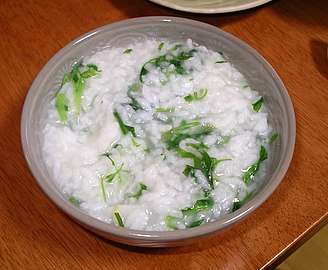Oenanthe javanica
Oenanthe javanica, commonly Java waterdropwort,[2] Chinese celery, Indian pennywort, Japanese parsley, water celery, water dropwort and minari,[3] is a plant of the water dropwort genus originating from East Asia. (Chinese celery is also the name given to Apium graveolens var. secalinum). It has a widespread native distribution in temperate Asia and tropical Asia, and is also native to Queensland, Australia.[4]
| Oenanthe javanica | |
|---|---|
 | |
| Scientific classification | |
| Kingdom: | Plantae |
| Clade: | Tracheophytes |
| Clade: | Angiosperms |
| Clade: | Eudicots |
| Clade: | Asterids |
| Order: | Apiales |
| Family: | Apiaceae |
| Genus: | Oenanthe |
| Species: | O. javanica |
| Binomial name | |
| Oenanthe javanica | |
| Synonyms[1] | |
| |
This plant should not be confused with the plants of the genus Cryptotaenia, sometimes called "Japanese wild parsley" (mitsuba in Japanese).
Description
Oenanthe javanica is a perennial herb that grows to about 1 m in height, with fibrous roots that emerge from all nodes, and flowers with 5 white petals and 5 stamens. The leaves are aromatic, glabrous, and have a sheath covering the stem. The leaflets are divided into lobes and crinkled.[5] The 'Flamingo' variety has colorful pink edges. The plant grows wild in moist areas, along streams and on the edges of ponds.
Culinary use
While many other species of water dropwort are extremely toxic, Oenanthe javanica is edible, and is cultivated in China, India, Japan, Korea, Indonesia, Malaysia, Thailand, Taiwan, and Vietnam, as well as in Italy, where its spring growths are relished as a vegetable.
India
It is commonly consumed in the Northeast Indian State of Manipur, where it is one of the main ingredients in Manipuri Eromba and Singju.
Japan
Called seri (セリ) in Japanese, it is one of the ingredients of the symbolic dish consumed in the Japanese spring-time festival, Nanakusa-no-sekku.
 Nanakusa-gayu (seven herb congee) eaten on Nanakusa-no-sekku (seven herb festival)
Nanakusa-gayu (seven herb congee) eaten on Nanakusa-no-sekku (seven herb festival)
Constituents
The plant contains persicarin and isorhamnetin.[6]
See also
References
- The Plant List: A Working List of All Plant Species, retrieved 12 May 2016
- "Oenanthe javanica". Natural Resources Conservation Service PLANTS Database. USDA. Retrieved 21 July 2015.
- Java waterdropwort/Oenanthe javanica - Wisconsin DNR, retrieved August 1, 2019
- "Oenanthe javanica". Germplasm Resources Information Network (GRIN). Agricultural Research Service (ARS), United States Department of Agriculture (USDA). Retrieved 2 August 2015.
- Tanaka, Yoshitaka; Van Ke, Nguyen (2007). Edible Wild Plants of Vietnam: The Bountiful Garden. Thailand: Orchid Press. p. 26. ISBN 9745240893.
- Anticoagulant activities of persicarin and isorhamnetin. Ku SK, Kim TH and Bae JS, Vascul Pharmacol., April 2013, volume 58, issue 4, pages 272-279, doi:10.1016/j.vph.2013.01.005
| Wikispecies has information related to Oenanthe javanica |
| Wikimedia Commons has media related to Oenanthe javanica. |



